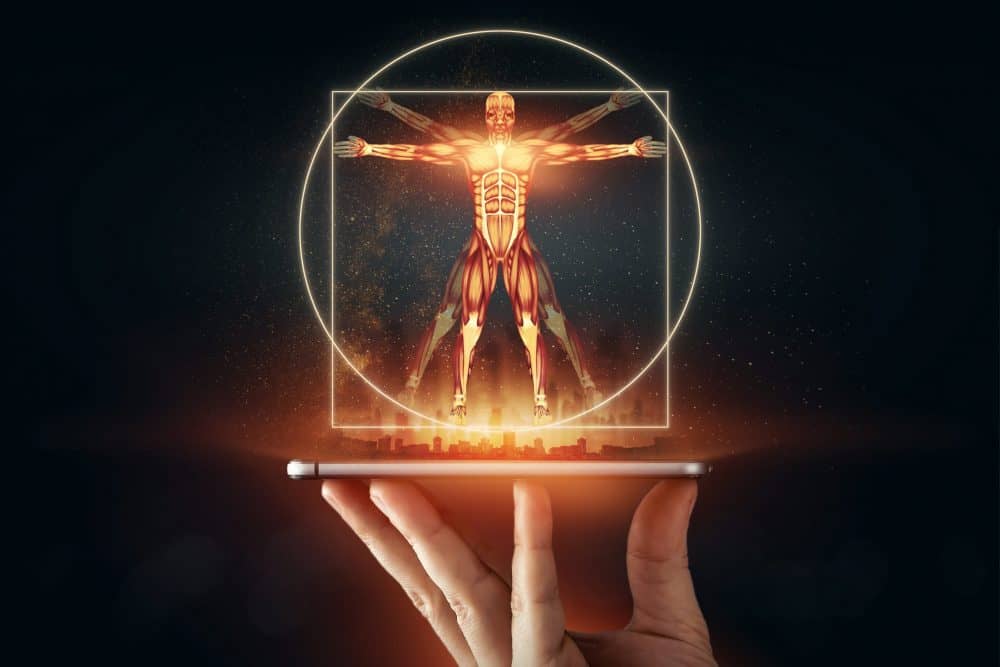The other day in the gym, a member asked a floor trainer for help with the exercise selector app on her smartphone. He looked straight at the phone and started tapping the screen. Success! He found the video clip on how to do a proper hip bridge. Then he walked away.
Did he ask her any questions? Maybe show her a few moves, or cue a few reps for her? You know, that whole rapport thing? Nope! He was too busy putting away dumbbells and closing a few open lockers. I wanted to scream at the trainer, “Forget the app! She wants your help! Show her the exercise, not the app!” Apparently his mind reader app wasn’t working that day.

Rise of the machines
In the fitness world, the tech wars have begun. Digital apps keep track of client data, fingerprint scanners have replaced membership cards, and cardio machine consoles can launch a satellite around the world.
But can it go too far? At what point does the digital interface remove the human element from our work? Is anybody worried about technology taking over the world and making trainers irrelevant?
Artificial intelligence, albeit an oxymoron, is taking over the world. Our mission, yours and mine, must be to protect the personal connection that drives this industry.
March on the populist uprising
We entered a helping profession to work with people, not machinery. What does it say for fitness trainers if clients trust a computer more than they trust people? You have dedicated years to gain the knowledge, skills, and confidence to make a difference in people’s lives.

Can you spot the supreme technology in this picture?
If you’re still reading this, then you are on board with the fight for humanity. You agree that technology should enhance, not replace. It should free us from mundane tasks in order to apply more thought process to the work we do.
Technology is fine as long as you are selective. Digital scales and heart rate monitors are excellent tools. An interactive calorie tracker can help you balance your diet better than I can (sips Coca Cola, the Peruvian kind with the real sugar – ahhh …). A virtual scheduling platform is more reliable than an old-fashioned appointment book.
The threat comes not from convenience, but from automation. We must draw the line when technology does our thinking for us. Sadly, many trainers and other industry professionals are only capable of work suited for a computer.
The usual suspects
Some people in this industry lack the interpersonal skills to inspire people, so they default to hard science. I once shared a workspace with a very narrow-minded corrective exercise specialist who said, “You can have fun with your client and make them laugh, but your job is program design” (He also routinely sexually harassed my clients and co-workers, but that’s a topic for another blog post).
There’s no doubting his clinical capability. He can find asymmetry in your posture, every biomechanical breakdown in your gait, and every compensation in your movement patterns. Too bad he doesn’t know how to answer the phone without a nervous giggle. He compensates for his social ineptitude by burying himself in biomechanics, and dismisses the human side of fitness training. Eventually, technology will replace his expertise.

What purpose do you serve?
If your entire job is to pre-determine reps and sets before the client ever sets foot in the gym, then somebody is developing an AI platform to replace you.
If you believe that all calories are the same, then a virtual nutrition coach is going to undercut your fees and take your clients.
If your only measure of fitness is the five components listed in a typical textbook, then a celebrity fitness app is going to walk your clients through a token strength circuit to train those five components better than you do.
If you want to outsmart the technology, employ better technology.
The supreme technology
The supreme technology in the gym is and always will be the human body. That should be your calling card whenever you are asked about cutting edge technology. Digital platforms cannot compete with a trainer who knows how the body works. No app or AI can understand motivation. Only you know what's happening in your clients' lives and how it affects their fitness.

If you have 20 clients, then you have 20 job descriptions. Some people need motivation, others need observation. Some want a carefully crafted three-month training macrocycle (allegedly), while other clients just want to learn a few new movements. Some people revel in the luxury of having a trainer, and others will never train unless they have a trainer. If you can tailor a unique experience for each person you train, no technology can replace you.
Form over function
In the education field, teachers write lesson objectives using form over function. We put the outcome first. For example, “Communicate future possibilities (form) using the first conditional (function)” or "find the product of single digit numbers using a multiplication table."
Tech designers do the opposite and say “we use artificial intelligence to hoobita hobita flabitaflivel.” Software designers, with all of their social aptitude, create apps in order to avoid people and remove the human element from our daily lives. They create artificial demand for a product that has no use.
Big tech investors have the power to shape the narrative and the media to tell you that you need it anyway.They promote technology without giving us a reason why we use it, which is the complete opposite of how the rest of the world works.
Do we even need the technology? Ask yourself what the app actually does, and if you can accomplish the same task by less complicated means. Most likely the tech accomplishes nothing on the gym floor, except to keep the client and trainer dialed in to the cell phone that shouldn’t even be present during a session.

Big tech promotion
Aside from the training session, social media is taking over the way that trainers promote their business. Again, we're replacing the human element with technology. We got into this business to get away from our computers.
Do you do your best work in front of a computer? I don’t. In fact, everything that you’re reading now was handwritten first, with the laptop closed. Freedom!

Enter the FIT Presenter
People ask me all the time why I teach speaking skills for the fitness industry, especially when speech coaching is far more lucrative in the corporate world.
Speaking and exercise have a lot in common. In both fields, people want to learn but are afraid to do it and afraid to ask. Most people need professional intervention in order to do it right. The most disturbing similarity, in my ever so modest opinion, is technological intervention.
Our digital masters have taken over public speaking too. We see online apps that count your verbs and your ums and ahs, but contribute nothing to grow your message. We see AI that will write your material for you, and it's driving academia into a frenzy. But no amount of technology will overshadow the face-to-face connection with your audience.
Public speaking is the number one marketing and promotion tool that your competition is not using. Let public speaking, communication at its most raw, be your example of how to resist technology.
Are you speaking to an audience on your gym floor? Let's meet for a 30-minute call and get your next presentation ready.















